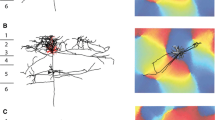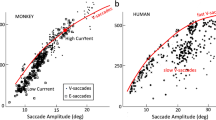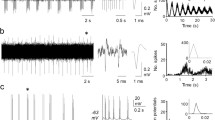Summary
The behaviour of neurones during signal transmission is determined partly by the input to the nerve cell and partly by its inherent properties. A detailed knowledge of the spike trains, which are input to and output from a synapse, may yield information about these synaptic mechanisms. This problem has been treated in relation to data from the dorsal spino-cerebellar tract (DSCT) cells monosynaptically activated from primary endings of muscle spindles. After a description of the firing pattern of these cells the behaviour of various models are examined by computer simulation. A particular type of model approximates the behaviour of the DSCT neurones closely with a rather narrow set of parameters. The model predicts that about 15 primary afferent fibres from one muscle converge on one DSCT cell and that the average size of their EPSPs may be as large as 50% of the threshold of firing.
Similar content being viewed by others
References
Alnæs, E., J. K. S. Jansen, and T. Rudjord: Fusimotor activity in the spinal cat. Acta physiol. scand. 63, 197–212 (1965).
Cox, D. R.: Renewal theory. London: Methuen 1962.
—, and P. A. W. Lewis: The statistical analysis of series of events. London: Methuen 1966.
—, and H. D. Miller: The theory of stochastic processes. London: Methuen 1965.
Dahl, O.-J., and K. Nygaard: Simula, Norwegian Computing Center, Oslo (1967).
Eccles, J. C., O. Oscarsson, and W. D. Willis: Synaptic action of group I and II afferent fibres of muscle on the cells of the dorsal spinocerebellar tract. J. Physiol. (Lond.) 158, 517–543 (1961).
Eide, E., L. Fedina, J. Jansen, A. Lundberg, and L. Vyklický: Unitary excitatory postsynaptic potentials in Clarke's column neurones. Nature (Lond.) 215, 1176–1177 (1967).
Eide, E., L. Fedina, J. Jansen, A. Lundberg, L. Vyklický On the properties of Clarke column neurones. Acta physiol. scand. (in press) (1969a).
Eide, E., L. Fedina, J. Jansen, A. Lundberg, L. Vyklický Synaptic excitation of Clarke column neurones. Acta physiol. scand. (in press) (1969b).
Enger, P., J. K. S. Jansen, and L. Walløe: A biological model of the excitation of a second order sensory neurone. Kybernetik 6, 141–145 (1969).
Firth, D. R.: Interspike interval fluctuations in the crayfish stretch receptor. Biophys. J. 6, 201–215 (1966).
Geisler, C. D., and J. M. Goldberg: A Stochastic model of the repetitive activity of neurons. Biophys. J. 6, 53–69 (1966).
Goldberg, J. M., H. O. Adrian, and F. D. Smith: Response of neurons of the superior olivary complex of the cat to acoustic stimuli of long duration. J. Neurophysiol. 27, 706–749 (1964).
—, and D. D. Greenwood: Response of neurons of the dorsal and posteroventral cochlear nuclei of the cat to acoustic stimuli of long duration. J. Neurophysiol. 29, 72–93 (1966).
Harvey, R. J.: The spino-olivo-cerebellar pathway of the cat. Thesis, Australian National University (1967).
Jansen, J. K. S., and P. B. C. Matthews: The effects of fusimotor activity on the static responsiveness of primary and secondary endings of muscle spindles in the decerebrate cat. Acta physiol. scand. 55, 376–386 (1962).
—, and T. Rudjord: Discharge pattern of neurons of the dorsal spinocerebellar tract activated by static extension of primary endings of muscle spindles. J. Neurophysiol. 29, 1061–1086 (1966).
—, and L. Walløe: On the inhibition of transmission to the dorsal spinocerebellar tract by stretch of various ankle muscles of the cat. Acta physiol. scand. 70, 362–368 (1967).
Jansen, J. K. S., K. Nicolaysen, L. Walløe The firing pattern of dorsal spinocerebellar tract neurones during inhibition. Acta physiol. scand. (in press) (1969).
Junge, D., and G. P. Moore: Interspike-interval fluctuations in Aplysia pacemaker neurons. Biophys. J. 6, 411–434 (1966).
Karlin, S.: A first course in stochastic processes. New York: Academic Press 1966.
Kuffler, S. W., R. Fitzhugh, and H. B. Barlow: Maintained activity in the cat's retina in light and darkness. J. gen. Physiol. 40, 683–702 (1956).
Lundberg, A.: Ascending spinal hindlimbs pathways in the cat. In: J. C. Eccles and J. P. Schadé (eds.), Physiology of spinal neurons. Progress in brain research, vol. 12, p. 135–163. Amsterdam: Elsevier 1964.
Matthews, P. B. C.: Muscle spindles and their motor control. Physiol. Rev. 44, 219–288 (1964).
Oscarsson, O.: Functional organization of the spino- and cuneocerebellar tracts. Physiol. Rev. 45, 495–522 (1965).
Rodieck, R. W.: Maintained activity of cat retinal ganglion cells. J. Neurophysiol. 30, 1043–1071 (1967).
Stein, R. B.: A theoretical analysis of neuronal variability. Biophys. J. 5, 173–194 (1965).
— The information capacity of nerve cells using a frequency code. Biophys. J. 7, 797–826 (1967).
—, and P. B. C. Matthews: Differences in variability of discharge frequency between primary and secondary muscle spindle afferent endings of the cat. Nature (Lond.) 208, 1217–1218 (1965).
Szentagothai, J., and A. Albert: The synaptology of Clarke's column. Acta morph. Acad. Sci. hung. 5, 43–51 (1955).
Walløe, L.: Transfer of signals through a second order sensory neuron. Thesis, Inst. of Physiol., Oslo University (1968).
Walløe, L. Transmission of information through a second order sensory neuron. In preparation (1969).
Author information
Authors and Affiliations
Rights and permissions
About this article
Cite this article
Walløe, L., Jansen, J.K.S. & Nygaard, K. A computer simulated model of a second order sensory neurone. Kybernetik 6, 130–141 (1969). https://doi.org/10.1007/BF00274106
Received:
Issue Date:
DOI: https://doi.org/10.1007/BF00274106




